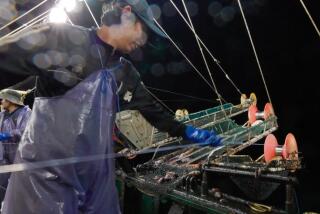Catch-and-Release: Is It Humane or Not?
- Share via
The most significant development in angling over the last half-century is the advent of catch-and-release, which seems beyond reproach. Anglers get their kicks stalking and fooling wily wild fish but afterwards, instead of going under a broiler, the fish go back to where they came from, generally no worse for wear and ready to strike someone else’s lure.
Everyone appears to benefit. Most fish survive so anglers get to catch them again, and in the process anglers grow better attuned to the requisites of a healthy, natural fishery--water quality, cover, flow, nursery areas for young to hatch and grow--and more vigilant in protecting and defending them.
But as positive as it sounds, catch-and-release has detractors. Many Europeans think it’s ridiculous for people to waste time stalking and catching fish only to let them go. “They believe you should creel your fish,” said Charles Gauvin, president of Trout Unlimited. Indeed, on some European streams catch-and-release has been banned, said longtime TU member Jay Sheppard.
In the United States, some wildlife lovers are challenging the practice as cruel. Recently I got a postcard from a reader in Columbia, Md., expressing dismay at a column about catching-and-releasing trout on Big Spring in Pennsylvania.
“Today’s account of you and your friend’s tormenting of 50 trout in 4 1/2 hours just nauseates me,” wrote Helen Thompson. “There is nothing civilized about ‘catch-and-release.’ How would you like to be yanked out of your environment and tossed about?”
Well, sometimes that doesn’t sound so bad, to tell the truth, but mostly I’d rather be left alone, as most fish surely would. How, then, to justify pricking them in the chin with tiny hooks and amusing ourselves with their struggle, only to let them go when it’s over?
It isn’t only about trout, either. Catch-and-release started on Michigan trout streams in the 1950s but it’s booming now for largemouth and smallmouth bass in rivers and lakes, for rockfish along the coast, for marlin and blues offshore, spawning shad in the spring, even giant tuna in winter off Cape Hatteras, where anglers may keep just one fish per boat per day despite paying up to $1,000 for the pleasure of fighting the pelagic bruisers.
Are we demented perverts taking pleasure in hectoring wildlife or is catch-and-release the civilized solution to the inevitable clash of too many people trying to enjoy too few fish?
“I’m not a partisan either way,” said Gauvin. “It’s certainly necessary if we’re going to maintain populations of wild fish, but at the same time it is possible to go to places like the South Platte in Colorado and the San Juan in New Mexico where the fish are battered, their lips are bruised from being caught so many times.”
So what’s the answer, a catch-and-release limit of 10 fish a day with Natural Resources police lurking behind bushes with calculators, keeping track of how many trophies each angler sets loose?
“I hope not,” said Bob Bachman, the Maryland Fisheries Service’s director of resource management. “I think state agencies need to put in place the bare minimum of regulations to make sure the resource is there for future generations. Then we need to provide users with information so they can decide for themselves what’s appropriate behavior.”
“Aesthetically, the best fishing most of us do involves catching three or four good fish over a long day,” said Gauvin.
Personally, my idea of the perfect fishing circumstance is the one presented by John Hersey in the superb book “Blues,” in which he recounts summers spent on Nantucket Island, where he’d watch the sky and the sea for the perfect conditions, then put out alone in a skiff to catch a single bluefish, which he immediately brought home to clean and cook for supper.
That’s what fishing should be like, but our world is a complicated place and most of us don’t have the luxury. We may only get to fish once a month, on a day when conditions aren’t ideal, and we like to pack a lot of excitement and memories into a short span.
So we go to catch-and-release places and once in a while get lucky, and we may get carried away and catch too many and in the process look boorish.
More to Read
Sign up for The Wild
We’ll help you find the best places to hike, bike and run, as well as the perfect silent spots for meditation and yoga.
You may occasionally receive promotional content from the Los Angeles Times.






